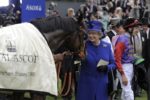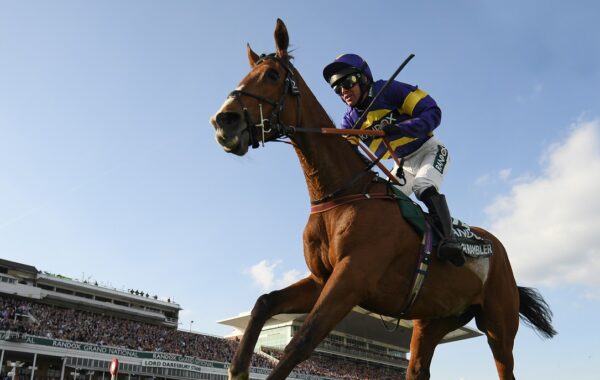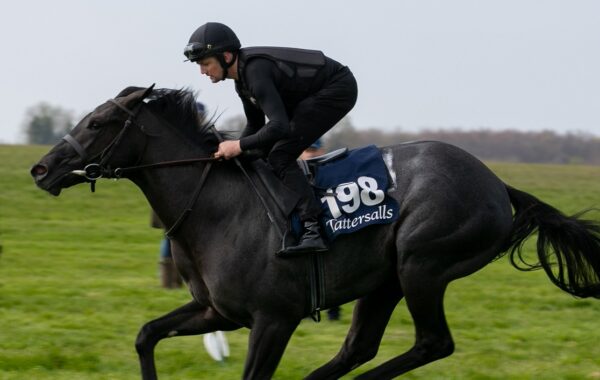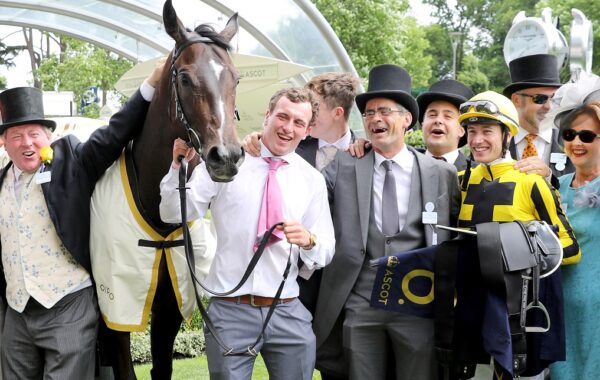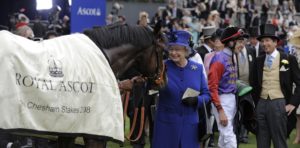Queen Elizabeth II was born into a family that had long shown an appreciation for the thoroughbred.
Her grandfather King George V, for instance, had owned Perdita, out of whom he had bred the Derby winners Persimmon and Diamond Jubilee.
The King, then Prince of Wales, was on hand to welcome both his Derby winners in person, in 1893 and 1900 respectively, and was again present when his Captain Cuttle filly Scuttle triumphed in the 1,000 Guineas at Newmarket many years later in 1928. Hers was a particularly important victory in that it marked the first Classic triumph by a horse bred and owned by a reigning monarch.
When King George VI acceded to the throne in 1936, the Royal Studs were numerically strong but overall at a low ebb. To aid the situation, his racing manager Captain Charles Moore arranged for the stud to lease several yearlings from the National Stud and, in return, its racing fortunes began to take a turn for the better, notably in 1942 when the King’s Big Game and Sun Chariot carried all before them. There is a story of the Royal family visiting Fred Darling’s yard at Beckhampton to view Big Game and Sun Chariot ahead of their summer Classic engagements. Big Game, then the unbeaten winner of the 2,000 Guineas and favourite for the Derby, was brought out for inspection and Princess Elizabeth was allowed to run her hand over the colt; so taken was the future Queen with the horse that she is believed to have told one of her racing managers many years later that she didn’t wash her hands for several hours afterwards.
As an aside, while Big Game captured the imagination during that Royal visit, the 1,000 Guineas winner Sun Chariot disgraced herself by charging off into a ploughed field, where in the words of her jockey Sir Gordon Richards, “she got on her knees and roared like a bull”. Such obstinate behaviour had become typical of Sun Chariot at that stage of her career, but it failed to stop her progress, with the filly going on to win the Newmarket Oaks and St Leger. Only Big Game’s run in the Derby, when sixth, deprived King George VI of a sweep of the Classics in 1942.
Several years later, Princess Elizabeth was present to see her father’s homebred Hypericum win the 1,000 Guineas, achieved despite unshipping Doug Smith prior to the race and running free across the Rowley Mile. The Princess had followed Hypericum’s development from her days as a foal at Hampton Court and had also been present to watch the filly win the previous year’s Dewhurst Stakes.
Hypericum, as a daughter of Hyperion and the 1,000 Guineas runner-up Feola, encapsulated the nature of the Royal Studs at that time, given that it would glean much of its success over the next few years from the influences of both those parents. That much is especially true of Feola, a 3,000gns yearling acquisition in 1934 by Brigadier-General ‘Mouse’ Tomkinson on behalf of the King from whom the likes of Highclere, her daughter Height Of Fashion and Deep Impact would later descend.
Accession
When the Queen inherited the Royal Studs in 1952, it was home to around 20 mares including Feola, then 19, as well as Hypericum and her accomplished half-sisters Angelola and Above Board, both winners of the Yorkshire Oaks. Captain Charles Moore remained as racing manager.
Captain Cecil Boyd-Rochfort sent out Choir Boy to become the Queen’s first winner in a Newmarket handicap that spring and there was further success when the colt followed up in the Royal Hunt Cup in the summer.
Better was to come, however, since Boyd-Rochfort’s Newmarket yard also housed Angelola’s first foal, the Hyperion colt Aureole, then a two-year-old. Aureole was a typically highly-strung Hyperion who required patience from his trainer, and as a result he faced the starter only twice at two, notably when making a winning debut in the Acomb Stakes at York.
The following spring, Aureole ran well to finish fifth in the 2,000 Guineas to spark thoughts of a legitimate shot at the Derby, hopes that were further consolidated when he won the Lingfield Derby Trial impressively. With the Derby staged just days after the Queen’s Coronation, the scene was set for a popular result, but while Aureole ran a winning race, he was unable to overhaul Pinza, whose win provided Sir Gordon Richards with a much deserved first Derby success.
Aureole went on to win the Cumberland Lodge Stakes at Ascot. However, by that stage, he had become uncooperative at home, a problem that required the intervention of Dr Charles Brook, a neurologist who had developed a therapy that involved the laying on of hands. This approach appeared to settle Aureole, although he also seemed to go better for Eph Smith rather than the stable jockey Harry Carr. It was under Smith that he had won the Cumberland Lodge and the partnership thrived the following year when successful in the Coronation Cup, Hardwicke Stakes and King George, the latter won bravely in a tight finish from Vamos.
It was the Queen running to greet her champion
As recalled by Bill Curling in The Captain, his biography of Boyd-Rochfort, Aureole’s King George provided much cause for celebration. “I remember hurrying to see Aureole return to the unsaddling enclosure,” he wrote, “and as I reached the ground level a small figure came racing by. It was the Queen running to greet her champion. Kings and Queens are not often seen running in public…. behind the Queen, hopelessly outdistanced, came her septuagenarian racing manager Captain Charles Moore.”
Thanks primarily to Aureole’s achievements, and that of the regally-bred Landau (a Dante son of Sun Chariot) in the Sussex Stakes, the Queen ended 1954 as leading owner, a feat she was to achieve again in 1957.
Aureole retired to Wolferton Stud, where he sired Derby winner St Paddy, Arc winner Saint Crespin and Vienna, sire of Vaguely Noble. He was twice champion sire, in 1960 and 1961.
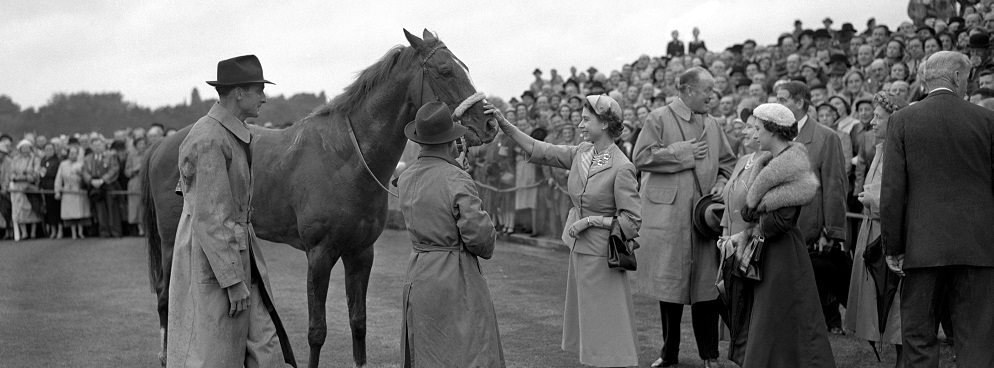
Aureole pictured with the Queen following his success in the King George
Aureole today remains ranked alongside some of the best horses raced by the Queen. However, he wasn’t the only major runner of the 1950s to carry the Royal silks.
In the 1958 2,000 Guineas winner Pall Mall, there was a first Classic homebred winner. The flashy son of Palestine was produced by a mare, Malapert, who had been bought by Moore for just 100gns out of training. As an individual, he also possessed questionable forelegs – “terrible” in the words of Boyd-Rochfort. But the trainer was able to keep him sound and in return Pall Mall won the 2,000 Guineas at 20-1, with his better fancied stablemate Bald Eagle well beaten, and two renewals of the Lockinge Stakes. He later stood in Ireland.
Homebred High Veldt, meanwhile, ran second to Ribot in the 1956 King George, a year prior to the Classic campaigns of the three-year-old fillies Almeria, Mulberry Harbour and Carrozza.
As with all the Royal homebreds, Almeria and Mulberry Harbour were trained at Freemason Lodge by Boyd-Rochfort. Carrozza, as one of the yearlings leased from the National Stud, headed to Noel Murless at Warren Place.
Almeria was closely inbred to Hyperion, being by Alycidon out of the King’s Coronation Stakes winner Avila (by Hyperion). It was a mating that could have yielded brilliance as well as temperament, and Almeria wasn’t short of either.
Brought to hand steadily, she won the Ribblesdale Stakes, Yorkshire Oaks and Park Hill Stakes to end the year rated as the best British three-year-old filly of 1957. She was kept in training at four but with minimal success, with a second to fellow Royal colour-bearer Agreement in the Doncaster Cup the highlight. Agreement was Almeria’s lead horse at home, so the win was somewhat unexpected. But he was an excellent stayer on his day, as he showed the following year when taking the Chester Cup ahead of a second Doncaster Cup.
“Carrozza was a fat little lady and a bit lazy but full of guts,”
Behind Almeria in second and third on the 1957 three-year-old filly ratings were Carrozza and the Cheshire Oaks winner Mulberry Harbour. The pair had met in the Oaks, in which the diminutive Carrozza, partnered by Lester Piggott in the second colours, had come out on top in a desperate finish over the Irish filly Silken Glider.
“Carrozza was a fat little lady and a bit lazy but full of guts,” Piggott was quoted as saying afterwards. “She was dying in the last hundred yards, but she gave everything she had got.”
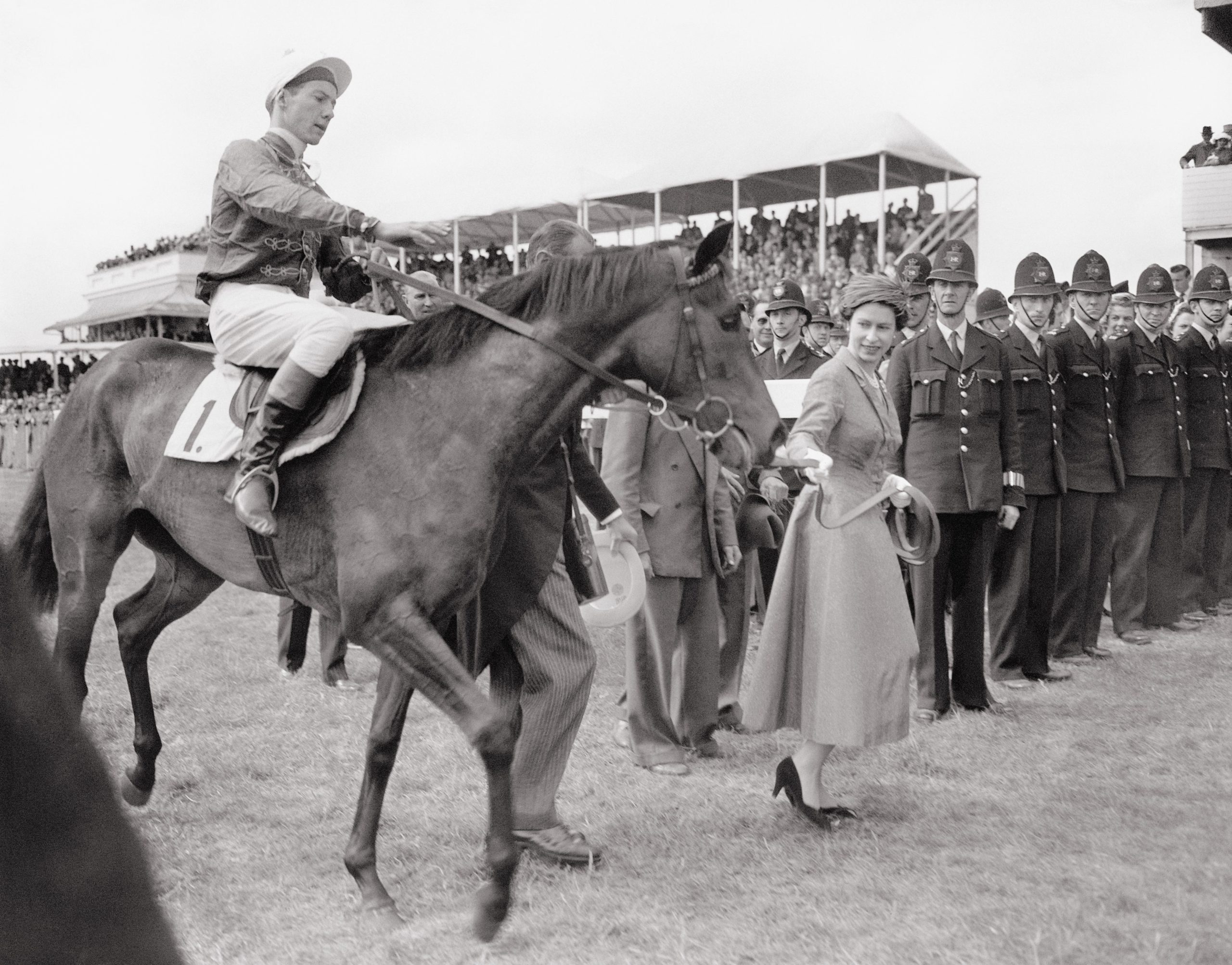
The Queen leads in her Oaks winner Carrozza, with Lester Piggott in the saddle. Photo – PA
That same year, Above Board’s son Doutelle won the Lingfield Derby Trial, and although not in the same class as that year’s Derby winner Crepello at Epsom, went on to inflict a defeat on Irish champion Ballymoss in the following year’s Ormonde Stakes at Chester. A firm favourite with connections, particularly jockey Doug Smith, Doutelle was retired to stand at Sandringham Stud but sadly died young. His younger half-brother Above Suspicion also added further to the family by winning the 1959 St James’s Palace and Gordon Stakes following an unlucky fifth to Parthia in the Derby.
1960s
Captain Moore retired in 1962, the year after Aiming High had carried the Queen’s colours to victory in the Coronation Stakes. One of Moore’s last acts was to purchase a yearling daughter of the short-lived Doutelle upon the instruction of the Queen at the 1961 yearling sales. Moore and Boyd-Rochfort settled on a half-sister to the 1955 Queen Mary Stakes winner Weeber from Chantry Stud and the filly in question, Amicable, proved to be an excellent choice, winning the Nell Gwyn Stakes and running a narrow second in the Yorkshire Oaks.
As anticipated, she also became an excellent addition to the stud as the ancestress of a host of high-class Royal runners; today, they include the Queen’s current one-time Derby hope Reach For The Moon.
Fellow yearling purchase Stroma also proved to be an asset.
In 1956, the Queen had paid a visit to Doncaster yearling sales, where she picked out a filly by the sprinter Luminary. By chance, she was from the same female family as her first winner, Choir Boy, and with a bid of 1,150gns, Moore was able to secure her for the Royal Studs. Named Stroma, she was stakes-placed at two but really came into her own at stud, notably as the dam of Canisbay and granddam of Dunfermline.
Injury had cut short the three-year- old career of Canisbay, a son of Doutelle, meaning that he was best as an older horse in 1965. In a year where Boyd-Rochfort’s string was laid low by the virus, the trainer was reportedly wary of running him in the Eclipse Stakes, which would only be his fourth racecourse appearance. But it is said that the Queen was keen for him to take his chance and she was duly vindicated, as he held on from Roan Rocket in a desperate finish to win as an unconsidered 20-1 shot. It was the first Royal victory in the race since Diamond Jubilee 65 years before.
At stud, Canisbay went on to take the place of his sire at Sandringham, where he left behind the Italian Derby winner Orange Bay among others before his sale to Italy.
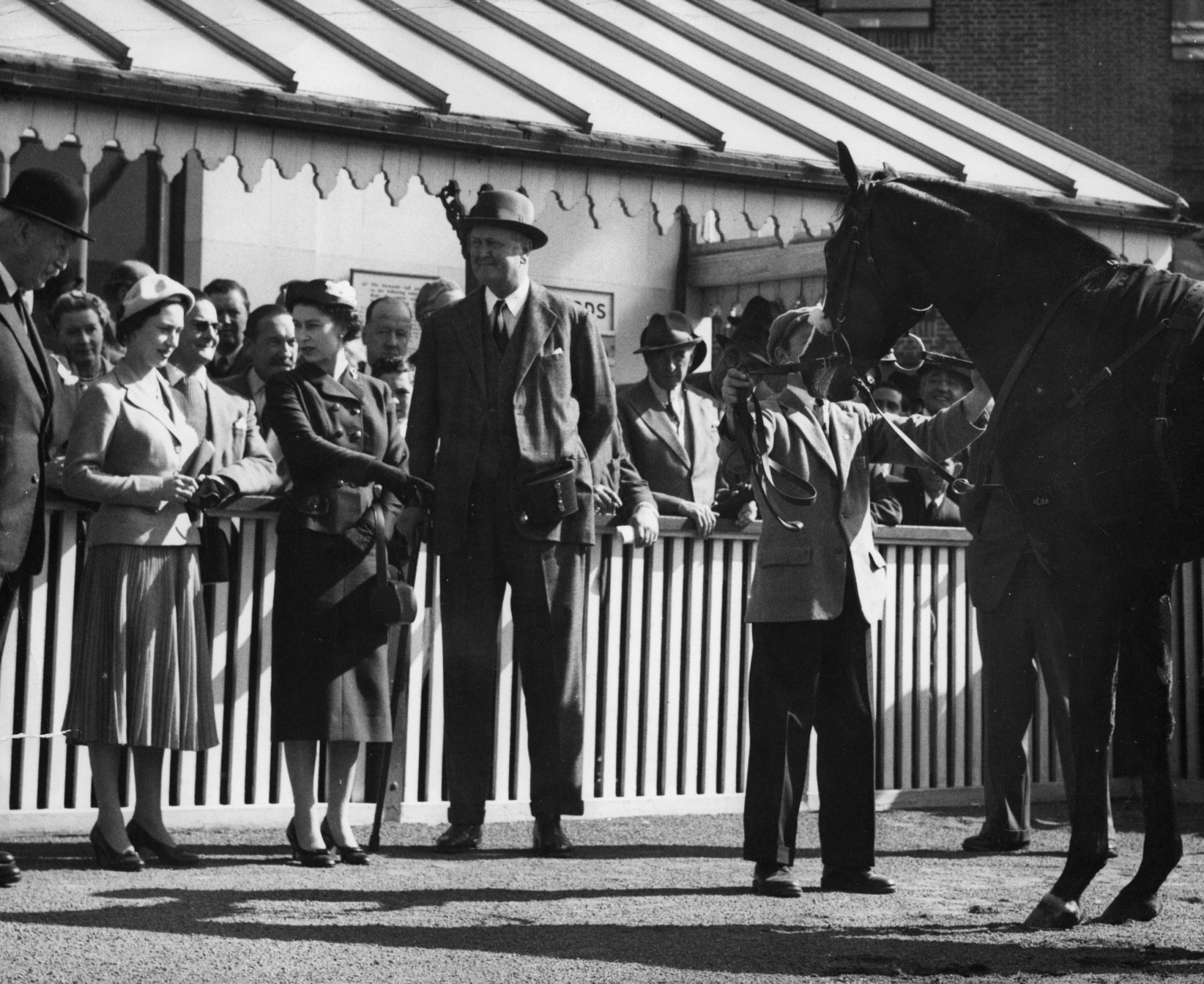
Doutelle, pictured at Kempton with the Queen, Princess Margaret and Captain Charles Moore, was a favourite. Photo – PA
Several stayers also carried the Royal colours with distinction during the 1960s, notably the Aureole gelding Apprentice, who overcame leg problems to win the Yorkshire and Goodwood Cups in 1964 and 1965, and Gaulois, who provided Boyd-Rochfort with a last big staying race win in the 1966 Goodwood Cup. The trainer’s last winner for the Queen arrived in 1968 with the victory of Castle Yard in the Zetland Gold Cup.
By that time, Major Richard Shelley was coming to the end of his tenure as manager of the Royal Studs. Lord Porchester was made racing manager and Sir Michael Oswald appointed to take over the running of the Royal Studs.
The last major winner of the decade, Hopeful Venture, was also one of the last yearlings to be leased by the National Stud. Appropriately a son of Aureole, Hopeful Venture was patiently handled by Sir Noel Murless, rising through the ranks to run second in the St Leger before returning at four to claim the scalp of Park Top in the Ormonde Stakes and Vaguely Noble in the Grand Prix de Saint Cloud.
1970s
It was against the backdrop of the Queen’s Silver Jubilee celebrations that Dunfermline, a granddaughter of yearling purchase Stroma, announced herself as one of the best middle-distance three- year-olds of 1977.
By Royal Palace, the 1967 2,000 Guineas and Derby winner, Dunfermline was out of Bath maiden winner Strathcona and was one of a number of memorable Royal performers trained during the period by Major Dick Hern at West Ilsley.
As befitted her breeding, Dunfermline was a robust filly who gave the impression she would do well with time and distance. Yet she was also a useful two-year-old, one who was forward enough to run placed in both the May Hill Stakes and Fillies’ Mile.
“I was a bit disappointed pulling up as I couldn’t find anyone with a Union Jack flag to walk in with”
Come the end of 1976, Willie Carson was appointed to replace Joe Mercer as West Ilsley first jockey, and therefore it was under the Scot that Dunfermline went into the history books as a dual Classic winner.
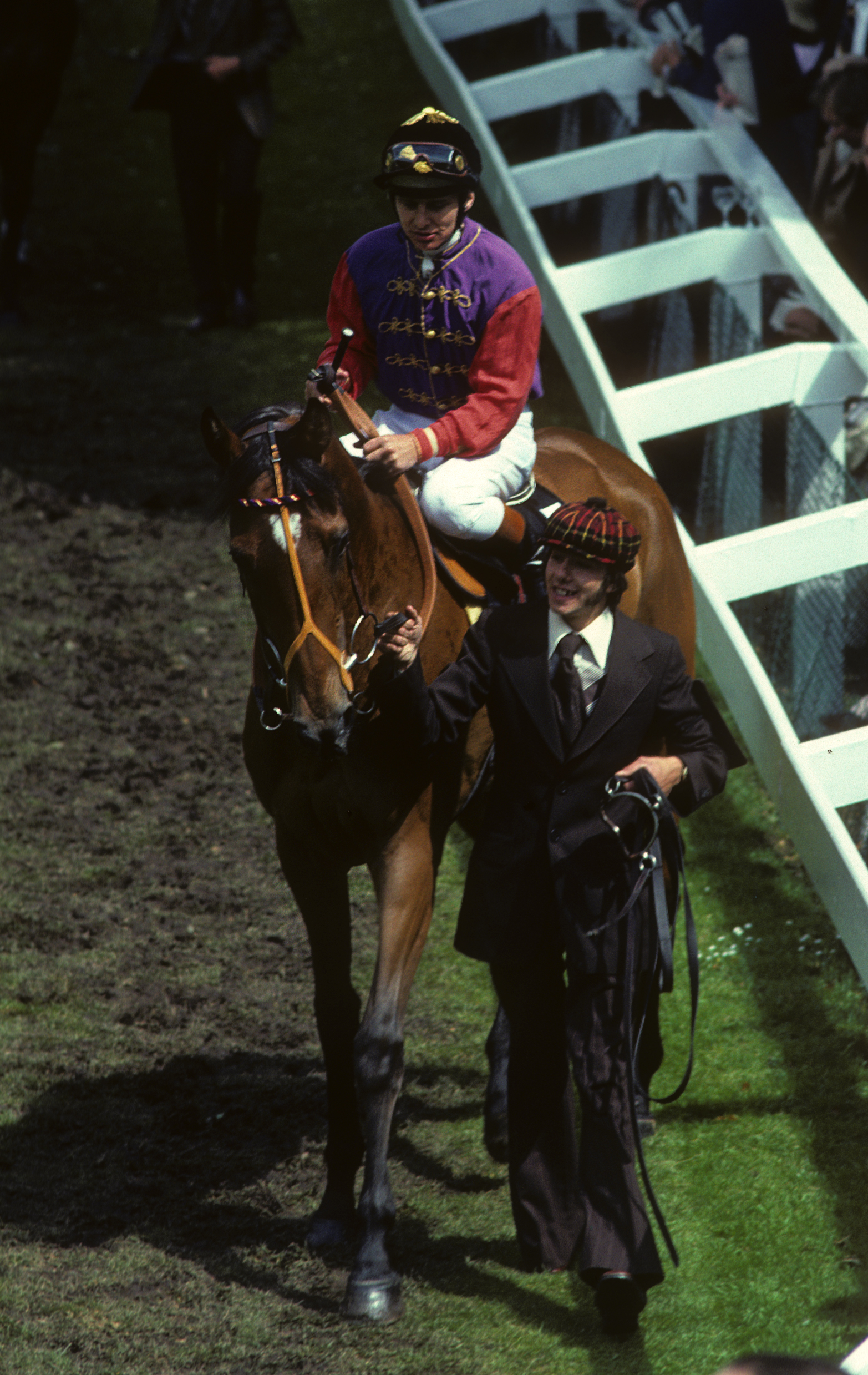
Dunfermilne captured the Oaks and St Leger in Silver Jubilee year. Photo – George Selwyn
“She was a big, rangy, plain filly,” recalls Carson. “I wasn’t in love with her – she didn’t excite at home – but the Major had always liked her and in hindsight, he was training her for one race, the Oaks.
“She had just the one race before Epsom in the Pretty Polly Stakes at Newmarket, and she was workmanlike. It was a bit sharp for her.
“Obviously, it was exciting to win a good race for the Queen, but she didn’t give me the feel of a brilliant animal. She didn’t say anything to you, she just went about her business and did what she had to do. Dare I say it, you’d almost call her a dour stayer.”
While the mile-and-a-half distance of the Oaks was expected to play to Dunfermline’s strengths, much of the pre-race attention focused on Robert Sangster’s Cheveley Park Stakes winner Durtal. That filly unshipped Lester Piggott on the way to the start, however, leading to her withdrawal. Nor had Carson escaped his own drama, having been caught up in a car accident on his way to the course.
“I left a message that I would be there but that I would be late,” he says. “Of course, there was pandemonium – of all the days for that to happen. Dick got another jockey lined up, but I was able to get another car and finally made it to the track.
“I was drawn one in what was supposed to be the coffin box, and the race didn’t go to plan. At the top of the hill I was a bit further back than I wanted to be. We got on the outside and I could see the two Cumani fillies [eventual second Freeze The Secret and third Vaguely Deb] in front of me. My filly hung like a barn door all the way down the straight even though I had my stick in the left hand. All she wanted to do was lean on those two fillies, but she still got up.
“I was a bit disappointed pulling up as I couldn’t find anyone with a Union Jack flag to walk in with. But it was one of the greatest thrills of my career. Silver Jubilee year – it was fairytale stuff.”
Dunfermline headed to York thereafter for the Yorkshire Oaks, where she ran an underwhelming third. It was widely perceived that a lack of pace had been her undoing that day, although Carson also recalls “that there was also a bit of coughing about”. To that end, a pacemaker in the form of the Queen’s Glasgow Stakes winner Gregarious was employed for the St Leger, in which she defeated champion Alleged after a hard-fought battle. Later that day, her half-sister Tartan Pimpernel won the May Hill Stakes to cap a wonderful day for all involved.
“The Leger proved just what a good filly Dunfermline was,” says Carson. “There was a lot of chat about Alleged as he had won the Great Voltigeur [by seven lengths] and the St Leger ended up being the only time he was beaten. She had to be a good filly to do that.”
Alleged subsequently turned the tables on Dunfermline in the Arc but the filly still ran a game race to be third. She was kept in training at four but with little success and retired to stud. Sadly, she left behind only four foals, including one filly who was unable to extend the line.
Hern’s first group of Royal yearlings had arrived in 1966
Hern’s first group of Royal yearlings had arrived in 1966, and not long afterwards, a batch would come to include a Pall Mall daughter of Almeria. Foaled in 1968 and named Albany, the filly provided such a headache early on in her three-year-old career that it was suggested she should be put in foal. Sent to Highclere Stud’s Queen’s Hussar, the strategy had the desired effect and thus it was a more amenable Albany that successfully progressed through the season to ultimately win the 1971 Prix de Psyche.
Hern’s yearling intake the following year included a granddaughter of Hypericum named Highclere, by Queen’s Hussar and out of the stakes-placed Highlight.
Hern, who had already enjoyed great success with the progeny of Queen’s Hussar as the trainer of Brigadier Gerard, remembered Highclere as “a lovely bay filly with plenty of scope and a good stride”. A big sort, she ran second in the Princess Margaret Stakes and won her third race, a maiden, as a two-year-old. As anticipated, she progressed markedly over the winter.
Queen’s Hussar had done much of his best racing when equipped with blinkers, notably when winning the Sussex Stakes, and Highclere was cut from a similar cloth. Equipped with headgear, she lined up in the 1,000 Guineas without a prep run and, under a forceful Joe Mercer ride, held off the closing Polygamy to win by a head.
It was felt in the aftermath of the race that the undulations of Epsom would not play to her strengths and therefore the Prix de Diane at Chantilly was nominated as a suitable target. The Queen made a private visit to watch the race and in front of an enthusiastic crowd Highclere bounded away to win easily and become the first – and to date only – filly to pull off the Newmarket 1,000 Guineas – French Oaks double. She subsequently ran second to Dahlia in the King George before heading to stud, where in her first year she produced the Princess of Wales’s winner Milford to Mill Reef ahead of the influential Height Of Fashion in 1979.
At around the same time, Ian Balding’s Kingsclere yard was also home to a number of high-flying Royal runners. Balding had started training for the Queen during the mid-1960s and there began a successful association with Kingsclere that endures to this day.
The Balding-trained Magna Carta, another classy performer out of Almeria, was one of the most progressive stayers of 1970, racking up five wins culminating in the Doncaster Cup. Sadly, he died early the following year.
The loss of a potential Gold Cup horse may have been alleviated somewhat by the achievements that year of Example, an Exbury filly out of Amicable, who landed the Park Hill Stakes and Prix de Royallieu under a pair of masterful waiting rides from Piggott. Kept in training at four, she also went on to win the Prix Jean de Chaudenay.
Several years later, Example’s sister Expansive added further to the family when saddled by Hern to win the 1979 Ribblesdale Stakes. Her victory came at the same meeting that fellow homebred Buttress won the Queen’s Vase.
Another high-class Balding-trained Royal runner of the 1970s, the Jimmy Reppin filly Joking Apart, won the Strensall Stakes and ran third in the 1975 1,000 Guineas.
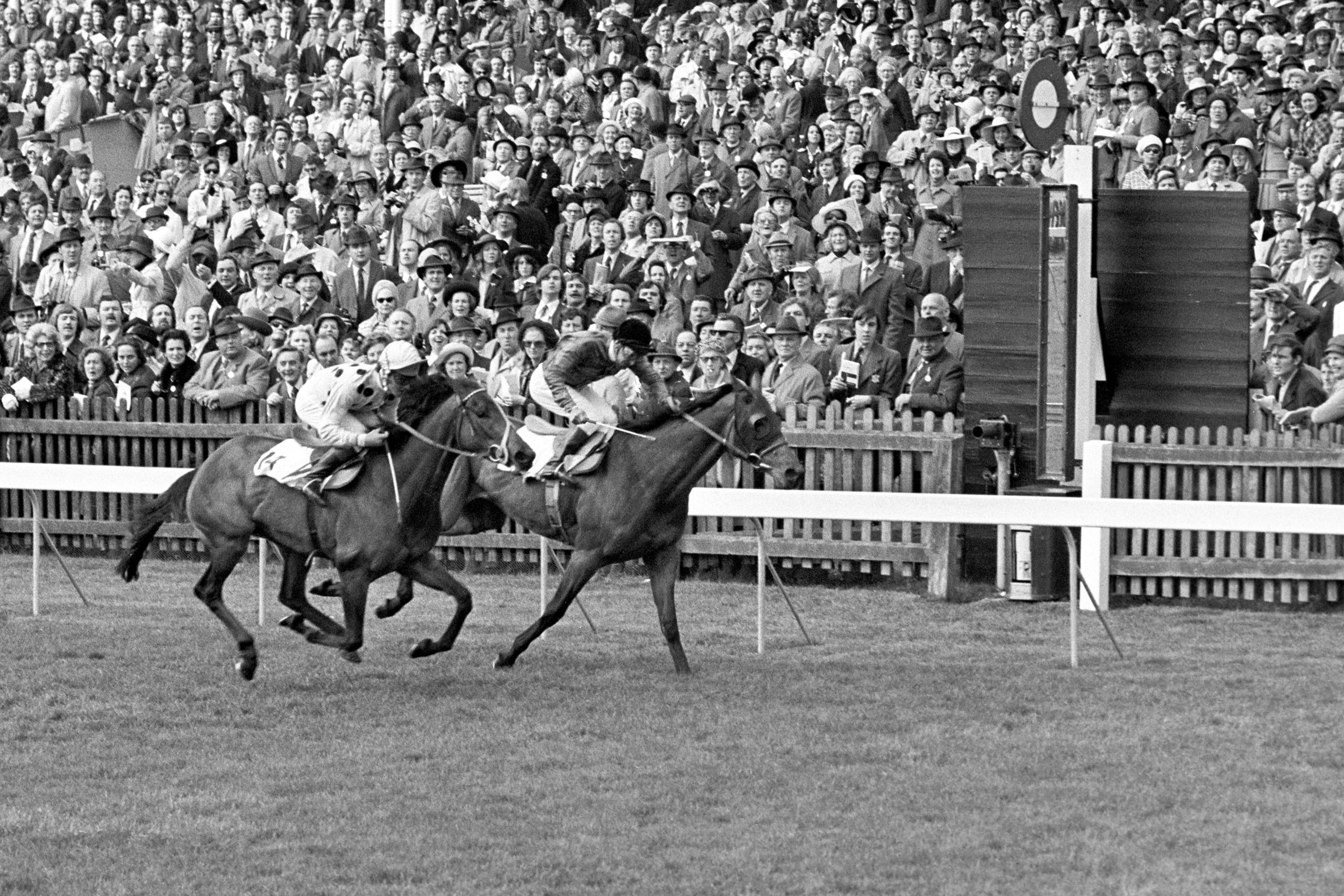
Highclere hangs on from Polygamy in the 1974 1,000 Guineas. Photo – PA
1980s
The new decade opened with abundant promise in the form of the Queen’s Hussar colt Church Parade, a close relation to Highclere who was saddled by Hern to win the 1980 Champagne Stakes at Goodwood.
“He was out of my first winner for the Queen, Christchurch,” says Carson. “He looked good at two and I remember saying to the Queen when I received my OBE that year, ‘Ma’am, I think I can win the Derby for you next year’. He was a backend two-year-old then and the signs were good, but he didn’t really go on the following year, which was disappointing.” Church Parade did line up in the Derby but finished a distant fifth to Shergar.
Meanwhile, there were also the early crops of Bustino to look forward to. Aureole had died at the age of 23 in 1973, leaving a gap on the Wolferton Stud roster. The Royal Studs had for a time been home to the Irish Derby and St Leger winner Ribero but he was a generally disappointing sire and by 1978 had also been sold to Japan.
Enter Bustino. Chiefly remembered for his epic tussle with Grundy in the 1975 King George, in which he narrowly came off second best, Lady Beaverbrook’s colt had been an excellent middle-distance horse under the management of Hern, for whom he had won the 1974 St Leger and 1975 Coronation Cup.
Upon his syndication to stud, the Queen acquired a quarter-stake in the horse, stood him at Wolferton and from his third crop bred Height Of Fashion out of Highclere.
“I had only 7 stone 12 and Ardross was having to give us a lot of weight [26 pounds],”
Foaled in 1979, Height Of Fashion was a typically big, rangy member of the family. Yet she was forward enough to make her debut in the Acomb Stakes at York’s Ebor meeting and, partnered by Piggott, went on to win well. From there, she won the May Hill Stakes at Doncaster before signing off her juvenile campaign with a victory in the Fillies’ Mile at Ascot. Come the end of the season, she was rated the joint-top European two-year-old filly of 1981.
A crunching fall at York that August had forced Carson to miss Height Of Fashion’s two-year-old season but he was back on board when she won the Lupe Stakes the following year from another one of the Queen’s fillies, Round Tower.
With it being decided that Height Of Fashion might not be seen to best effect around Epsom, she headed to the Princess of Wales’s Stakes at Newmarket for a clash with the brilliant older stayer Ardross.
“I had only 7 stone 12 and Ardross was having to give us a lot of weight [26 pounds],” says Carson. “So the Major and I sat down and devised a plan where we would jump out, make all and go flat out. That’s exactly what I did – I jumped out and went very fast and by the time we got to the two-furlong marker we were walking. But we managed to get to the winning post in front.”
In winning, the blinkered Height Of Fashion broke the track record for Newmarket’s mile and a half of the July course that had been set in the same race by her half-brother Milford in 1979.
It was following that tour de force that Sheikh Hamdan, then in the early stages of building his broodmare band, made a significant offer – believed to be in seven figures – to buy Height Of Fashion.
It must be remembered that the Royal Studs had plenty of the family at the time – Highclere herself was still in production alongside descendants of Hypericum –and in what was written up at the time as ‘the sale of the century’, the Queen accepted the offer and was able to fund her purchase of West Ilsley Stables from Sir Michael Sobell and Arnold Weinstock. When Height Of Fashion turned in low- key runs in both the King George and Yorkshire Oaks, she appeared well sold.
However, it soon became clear that Sheikh Hamdan had come into possession of a blue hen mare.
Had Height Of Fashion remained in Royal ownership, it is debatable as to whether she would have been exposed to any of the leading North American-based stallions of the time. As it was, to Blushing Groom she produced champion Nashwan, still remembered today as one of the best horses of his era. To Northern Dancer she produced the high-class pair Unfuwain and Alwasmi, while to Mr Prospector she foaled the classy fillies Bashayer, Wijdan and Sarayir, in turn the dam of 1,000 Guineas winner Ghanaati. Multiple Group 1 winner Nayef, by Gulch, was her final foal.
Appropriately, the majority were trained by Hern, mostly from Kingwood House Stables in Lambourn, to where he moved after his lease on West Ilsley controversially ended.
“Height Of Fashion was a big, rangy filly,” says Carson. “She wasn’t the most attractive. She was a good filly, though I wouldn’t have said she was a Group 1 animal. She was what I call a galloper.”
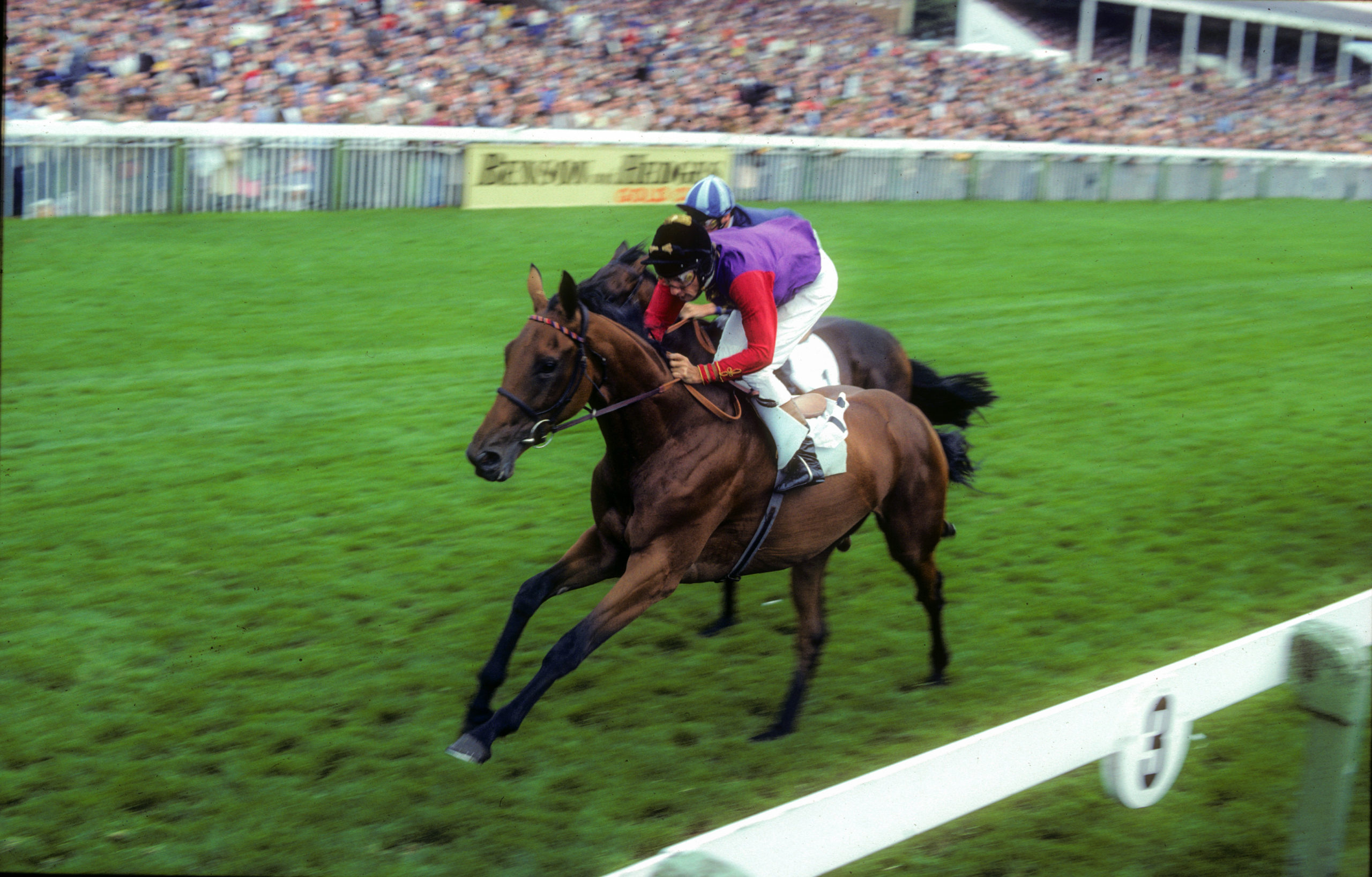
Height Of Fashion takes the Acomb Stakes on debut under Lester Piggott. Photo – George
While the 1980s weren’t as productive as some of the eras preceding it, there was also a landmark moment in the victory of Unknown Quantity, a homebred Young Generation gelding out of Pas De Deux, in the Grade 1 Arlington Handicap at Arlington Park. His dam had been the only surviving foal out of Example and yet, despite that, the family remains extremely relevant today; Pas De Deux is currently the ancestress of close to 20 stakes winners, including the Queen’s Chesham Stakes winner Free Agent and recent top American filly Duopoly.
Unknown Quantity was an important cog in that success. Foaled in 1985, he was trained by William Hastings-Bass and after he had won a pair of handicaps at Sandown and Lingfield as a four-year- old, an audacious plan was hatched to take on America. The $100,000 Arlington Handicap was quite a different task to the races Unknown Quantity had been contesting in Britain and he was duly sent off as the 10-1 outsider, yet he proved up to the challenge, scoring by three lengths under Jorge Velasquez to become the Queen’s first American winner.
In addition to Bustino, the Royal Studs at that time also stood Derby winner Shirley Heights, who had wasted no time in becoming one of Europe’s leading sires. However, by then the Queen was also making much more use of American- based stallions.
On one trip in 1984 she was able to visit Keeneland and view an array of leading stud farms including Claiborne Farm, then home to the likes of Mr Prospector, Danzig, Secretariat and Nijinsky. Living then in retirement was Round Table, one of the iconic American runners of the late 1950s, who had been bred by Claiborne out of Knight’s Daughter, herself bred by King George VI out of Feola. Knight’s Daughter had run up a hat trick of wins for the King but she hadn’t been an easy filly to train, her temperament testing all the skill of her trainer Cecil Boyd-Rochfort and jockey Doug Smith. Offered for sale at Tattersalls in 1951, the daughter of Sir Cosmo was snapped up for 2,500gns by Arthur ‘Bull’ Hancock, for whom she became a true blue hen.
Thus, upon learning that the mare’s celebrated son Round Table, then aged 30, was still a resident on the farm, the Queen requested to see him – a moment that was captured by American photographer Tony Leonard.
To read part two, the Queen’s horses; 1990s – 2020s, click here.


